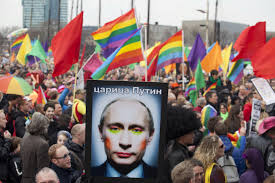
A photo of Russian President Vladimir Putin in makeup, at a rally in Amsterdam (Photo: Reuters)
BY CAVAN SIECZKOWSKI
Huffington Post Gay Voices
Four Dutch tourists have been jailed under Russia’s “gay propaganda” law after they were suspected of promoting homosexuality to children. According to a Huffington Post translation, the tourists arrived in Murmansk in mid-July to make a film about the city and the life of gay community there. While conducting a seminar with local LGBT group Center Maximum on Sunday, the police came in and arrested group chairman Kris van der Veen, as well as a camerawoman, a sound technician and a female student. Members of Center Maximum were also arrested.
The police were reportedly looking for minors at the meeting, according to Gazeta, but found none. They did, however, discover a 17-year-old in the film footage. The teen had told the crew he was 18 years old at the time of his interview, according to the report. Police were able to keep the Dutch tourists under the “homosexual propaganda” law.
Read more at Huffington Post Gay Voices







The Russian Orthodox Church is one of more reactionary and less salubrious religious institutions on the planet – if you think Western christianity is bad for gays or women, you’ll choke over orthodoxy, particularly in its Russian avatar. In my not so humble opinion, the Bolsheviks didn’t do enough to eliminate it (or any of the other religious mumbo-jumbo they came across). And its restoration to a central place in Russian society has thrust that society back beyond the nineteenth century.
The first constitution of the Russian Soviet Federative Socialist Republic (the Russian portion of what was to become the USSR), promulgated in 1918, was remarkably liberal on matters sexual. Divorce was legalized for the first time since Russia was christianized, as was abortion at all stages of pregnancy, and laws against ‘deviant’ sexuality (including homosexuality and prostitution) were abolished. These measures were later extended throughout the USSR.
It was the 1936 constitution that recriminalized homosexuality, restricted abortion and ‘discouraged’ divorce. Whether this, and the concomitant ‘recognition’ of the Orthodox Church, can be attributed to Stalin personally (“raised in a devout Georgian family,” “trained as an orthodox priest”) or to the bureaucracy’s perception of the demographic ‘needs’ of the USSR at the time is a question whose answer depends on one’s view of History – the point is that, like Napoleon’s 1801 Concordat with the Catholic Church, it was a dangerous concession to the past.
As the Soviet economy began to falter in the late 1980s as a direct result of the “reforms opening it up to market forces,” the Marxian formulation of “religion as the opiate of the people” began to be brought home in all its starkness. Religiosity increased, both in the USSR and in the other states of the Warsaw Pact (often promoted by Western interests). Anti-semitism had been a feature of othodoxy and of anti-communist rhetoric both inside and outside Russia, but had seemed defeated in the USSR itself, where, for example, over 100 Jews rose to the rank of general in WWII. It emerged again in the 1980s, hiding under the Soviet animosity toward the US client state of Israel, and has flowered in the new era of capitalism.
Like Gorbachev before him, Putin has made the Orthodox Church his ally in ‘reconstruction’ and social control. This latest move is a return to the ignorance, intolerance and obscurantism of Tsarist times.
(Incidentally, Putin has claimed that he views Stalin not as the heir of Lenin – much less of Trotsky! – but as a leader in the mould of Peter the Great and Catherine! :O )